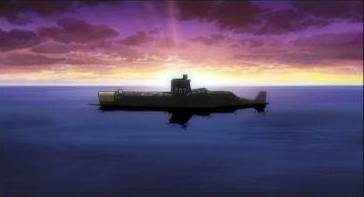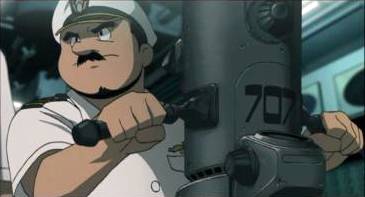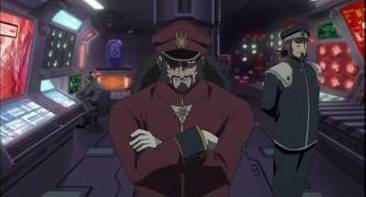|
Submarine
707R, released in Region 2 on 6th March by Manga
Entertainment, is based on the manga Blue Submarine
No.6, by Satoru Ozawa. Strangely, it appears that there
is another animé adaptation of this manga – named Blue Submarine No.6 – released as an OVA in 2000;
having never seen this, I can't comment on it, and even
if I had, I'd be loath to compare the two. From what I can
tell, the first series goes into more detail, having four
episodes to relate the story (compared to 707R's
two).
Set
in the near future, Submarine 707R focuses
on the conflict between the newly-formed Peace Keeping Navy
(PKR) – a coalition of naval forces supplied by several
UN member countries – and the terrorist group Underwater
Silence Revolution (USR), who wish to keep the oceans free
of man's interference. Yes, even though they're one of those
"bad guys with a pseudo-good cause", their leader
is portrayed as ruthlessly evil, and it is ok – for the
most part – to hate them. More on the leader later.

When
the USR's flagship, the UX, gate-crashes the PKN's
inception ceremony and destroys most of the fleet, Captain
Youhei Hayami – arriving late – is forced to sacrifice his
old but reliable submarine, the 707, to save the
PKN's flagship aircraft carrier. Several months later, Captain
Hayami is called back into service aboard a new 707
sub in order to patrol the oceans against the USR and its
leader, Admiral Red.
707R is an OVA – that's "Original Video Animation",
basically an animé series that is released on video
before it's seen on TV – in two "missions", though
it's really two parts of the same story. Mission
1 opens with a naval battle sequence, guest-directed
by Evangelion's Hideaki Anno, and then
gets right down to the USR-PKN conflict at the PKN's inception.
The rest of the episode deals mainly with the families of
both Captain Hayami and Admiral Red, and how they respond
to their husbands and fathers continually going out to sea.
Once
the backstory and characterisation parts of the story are
out of the way, Mission 2 can let loose
with the furious undersea battle between the new 707
and the UX. By the simple luck of the two captains
being the main protagonist and antagonist, respectively,
both supporting submarine fleets have been completely destroyed
– leaving the two submarines to battle it out one on one.
This sacrifice of realism for the sake of the story was
a little off-putting, but bearable.
I've
never been too much of a fan of "mechanical combat"
animé – things like Evangelion and
Gundam Wing never appealed to me. I had
Submarine 707R pegged as just another mindless
combat action animé, but I was pleasantly surprised
to find that the battles the subs engage in are handled
with strategy and grace. There's no air of "let's just
shoot and blow everything up" about it – as Captain
Hayami alludes to in the first episode, the battle between
the principal opposing submarines is akin to the "Tortoise
& Hare" story – with the 707 being the
slow and steady one, obviously. In the later stages, it
turns into a battle of wits between the two captains, each
desperately trying to outdo the other in terms of strategic
bluffs and maneuvers.

It's brave of this series to go with a protagonist who isn't
at the pinnacle of human fitness. Captain Hayami is a short,
portly man with a joculent demeanour; the type of design
usually reserved for the gluttonous buffoon character. Though
perhaps I've spoken too soon – 707R's got
one of those, too. He and his junior seaman friends conform
more to the animé-character stereotype than most
of the main characters, yet are shoved into the background
and given few scenes. Whether this was a conscious decision
on the part of the writer, or a constraint of only having
two episodes to tell the story, I don't know. The design
of Admiral Red, the antagonist, is less inspired; he's just
so stereotypically evil! He's got it all – an imposing
red uniform; long, unkempt black hair; a beard; and eyes
with wandering, insane pupils. And speaking of pupils –
the few women that we see (there are no female crewmembers
aboard either submarine) appear to have large, glassy eyes.
Either they have no pupils, or they're drawn very faintly.
The
submarines are often rendered with CGI, and with what appear
to be cel-shading techniques (as popularised in video games
like Dragon Ball Z: Budokai) – especially
shots of the two "Junior" mini-subs, and several
cruising shots of the 707 and UX. This
works quite well, though it often breaks the illusion of
realism with the 707's vibrant colouring. The aircraft
carriers are traditionally-animated, and incredibly detailed.
Finally, the various explosions and images of ships on fire
are excellently animated with bright orange and red tones.
At
times, the music seems as though it was written with a video
game in mind. The opening theme – a wistful piano piece,
heard throughout part 1 – juxtaposes with the thumping battle
music, and there are some exuberant "cruising"
themes to be heard too, as well as the traditional image
song. The English dubbing, though mostly good, falls a little
short of what I'd expect from the direction of Dave Wittenberg
– some of the jokes are a little hit and miss, and I get
the distinct feeling that it's either been lost in translation,
or is sailor's parlance that I don't quite understand.

One
criticism, however, that I would forward in regards to the
plot is that the story leaves so many hanging plot threads
in its wake. The USR/PKN conflict isn't resolved; there
are scenes with the family of Admiral Red that don't lead
anywhere; there are supporting characters that aren't themselves
supported. I blame this on only having two episodes to tell
a complete story in – it's obvious that these plot threads
were tackled in the manga, but that the restrictive two-episode
format of this animé wasn't enough to answer every
question raised.
In
conclusion: if you're a military-drama aficionado, you'll
likely lap this animé right up. In fact, if you're
a fan of mechanical combat animé in general, you
should enjoy it. But the series has just enough decent characterisation
to offset the action scenes and let casual animé
viewers in.
The
anamorphically enhanced 1.85:1 picture is good, with colours
and detail impressive and distracting compression artefacts
at a minimum. The CGI submarines in particular come over
well.
There
are three soundtrack options in two languages: Japanese
and English 2.0 stereo, 5.1 and DTS surround. Of the three,
the DTS tracks are the best, though its should be noted
that the Japanese and English DTS tracks appear to have
different mixes, with the Japanese track noticeably superior
– in places the English track is suprisingly flat by comparison,
though is fine elsewhere. The surrounds are well used in
the battle scenes, as is the LFE channel, and the music
is well spread throughout.
Unfortunately,
there are no special features present on the disc, save
for a Short Promotional Video
(2:10) showcasing Manga Entertainment's back catalogue,
the trailer for Submarine 707R itself,
and also for Ghost in the Shell: Stand Alone Complex
2nd Gig, Ghost in the Shell 2: Innocence
and Millennium Actress.
|